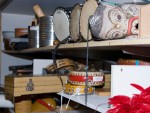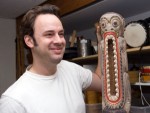Column Name
Title
In the heart of Juilliard’s third floor, behind locked doors that just a handful of people have keys to, lies a world where boys (sometimes shirtless) and the occasional girl run around making music by hitting things. Any things. Broken glass, 6-foot wooden boxes, bare chests, tambourines ... the list goes on and on as new “instruments” are always being invented. In his or her lifetime a percussionist will work toward acquiring a few of these: a marimba for a birthday, a flexitone for Hanukkah ... and if you’re really lucky, a good set of timpani will go on sale for the really low price of One Student Loan. No percussionist will ever acquire all these instruments, but luckily, the Juilliard percussion department has come wildly close.
Body
How many does it have? “Oh my God. Um. A quick estimate is 1,500 separate instruments,” said Nicola “Dr. Nic” Cannizzaro, Juilliard’s percussion instrument manager and a 1998 alum. Every spring he does inventory with the help of a few work-study students. They compile a list of every instrument, instrument stand, and mallet that the School owns, and no cymbal, clave, bass bow (used for a special effect on the vibraphone or crotales), or timpani is left behind. Also on the list are chromatic sets of every pitched instrument, including roto-toms, nipple gongs, and even house-tuned bell plates. Having such an extensive collection under one roof is extremely rare. Nearly every percussion manufacturer is represented, as are a host of cultures. Juilliard’s percussion collection is, according to Cannizzaro, probably the most extensive one on the East Coast. And it is constantly growing. “The philosophy here is that we should be able to do any piece of music we want because it’s a school,” Cannizzaro said. This often involves buying new instruments, renting them, or, if it’s cheaper, Dr. Nic makes them.
With the excitement of any new percussion piece, there also comes an undercurrent of fear that a name on that instrument list is unknown or simply not available in New York. But there’s a reason that they call Cannizzaro “The Doctor,” and that’s because he can track down, build, or at least replicate the sound of just about any instrument. In his three years in this position, Nic has built multiple sets of temple blocks, an entire set of long skinny drums called boobams, a pitched set of claves for Steve Reich’s Music for Pieces of Wood, a few sets of glass chimes, and shell chimes, to name just a few. Last year, a piece for percussion ensemble called for six Aztec death calls played by whistles that create really loud white noise that sounds like someone screaming. “There was nowhere to buy them; there was nobody [who] knew how to make them,” Cannizzaro said. “I found a picture online of a broken one that a professor in Mexico had found on a dig.” Using the photo as a guideline, he figured out how to make the whistles with polymer clay.
For Cannizzaro, building a new instrument is another fun day at work—his interest and talent for it span back to his first days of playing percussion, which he started doing when he was in ninth grade after abandoning his flute studies. But for the students and faculty in the percussion department, this resource is gold. “Nic could build a timpani with a fork and a spoon,” said second-year percussionist Matthew Thomas.
Another of Cannizzaro’s jobs is to maintain the instruments: Having thousands of instruments in the percussion department means that the need for repair and maintenance is monstrous. All percussionists are expected to have basic knowledge of instrument maintenance, such as how to change a snare-drum head and the proper way to move instruments, but a majority of repairs and maintenance require either a specialist—or more time than a student’s schedule can accommodate. Timpani heads should be replaced every year (including one set with $600 calf heads, which take days to change on each drum); cracked marimba bars need to be replaced as soon as possible; and instrument frames break down very easily from moving through doorways all the time (raised thresholds ruin the instrument frames). “Even just tightening a bolt every day is better than having to pay for a whole new frame,” Cannizzaro said. Bigger jobs for him include reshaping timpani bowls that have been smashed, and, for one student, rebuilding one of the department’s American sets of timpani to reflect the German system (in which the order of drums is reversed and the lowest one is on the right).
It’s not just the quantity of instruments in the Juilliard percussion department that make it unique, it’s also their history. The storage room is a museum of sorts, with Cannizzaro as its curator. In it, one may find drums that belonged to legendary Juilliard and New York Philharmonic alumni Elden “Buster” Bailey (his snare drum) and Roland Kohloff (a set of his chain drums). There’s also a turn-of-the-20th-century-looking field drum, lovingly called “Old Faithful.” As is often the case with string instruments, some of the best percussion instruments are antiques. The budget for the most recent Juilliard addition included funding for a new set of percussion instruments and timpani for the new fifth-floor orchestra studio. Cannizzaro contacted dealers and searched online to eventually find an antique glockenspiel, xylophone, and chimes. Additionally, donations are often made by former percussionists or collectors who give the School unique instruments: maracas with a decorative detail that looks like it could have been on the headpiece of a Las Vegas dancer, an antique pop gun that has yet to be used in a concert, an Easter Island-like wooden sculpture whose teeth make a guiro noise.
Juilliard’s instrument collection is nothing short of a percussionist’s dream. In the hidden storage hallway on the third floor, a mallet in hand will create more fun than a barrel of monkeys. At the end of the hallway is Dr. Nic’s workshop where there are half-beaded shekeres, unwrapped timpani mallets, and piles of wood waiting to be made into temple blocks. Some call it a tech department, but let’s be real: it’s more like Santa’s workshop.






